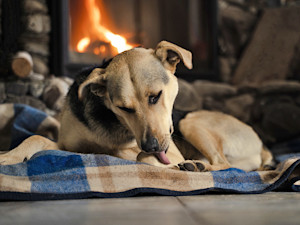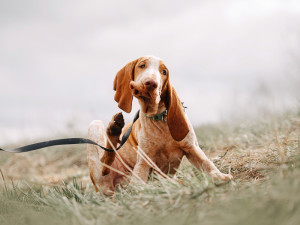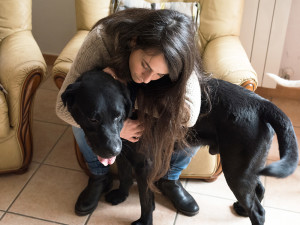Can You Treat Lick Granulomas in Dogs at Home?
Thankfully, there are several ways you can help your pup feel better.
“Acral lick granuloma” is not a term that playfully rolls off the tongue, but its complex, tongue-twisting terminology is probably a good reflection of the condition. It’s unsightly, uncomfortable, stubborn, and what you see is just the tip of the iceberg of your dog’s underlying problem. This skin condition is most common on the lower limbs or paws but can occur anywhere on the body. It often starts with an initial physical problem, such as an itchy or painful injury that your dog then tends to make worse by licking obsessively.
Many times, there is also a behavioral component to your dog’s incessant licking as well. The result is that your pup can end up with an area of damaged skin that may be raw, swollen, lumpy, painful, and even oozing like an open wound. It’s so hard to see your pup in pain, and if you’ve been struggling to help your pup resolve one of these, you know it’s not a simple fix. These are multifaceted problems that will require many treatments at the same time so your pup can get back to feeling their best. Read on to learn all about this condition and how to treat lick granulomas
Snap a pic of your pup’s teeth, and GREENIES™ will help you spot potential signs of oral health issues.
Lick granulomas in dogs are complicated. They have physical and psychological components that all need to be treated simultaneously. Some of these elements can and should be treated at home, while others will require a trip to the vet. To make things more challenging, there are many other skin conditions that can look similar to a lick granuloma, so it may be very difficult to know for sure that this is what your pup is dealing with unless you see your vet and get a thorough exam and diagnosis.
How much do you spend on your pet per year?
Additionally, there is no quick way to cure a lick granuloma; these typically take weeks to months to heal, and some dogs can be prone to recurrence. For all of these reasons, you need to bring the full arsenal of treatments to battle a lick granuloma. The best way to do that is to combine at-home treatments and ongoing therapies with diagnostic tests and prescription medications from your vet.
What is a lick granuloma?
Lick granulomas in dogs are a skin condition also known as acral lick dermatitis, or acral pruritic nodules. These terms all attempt to describe a skin condition that is itchy, painful and has a very dramatic appearance. The condition usually starts with some itchy or painful stimulus, which can include anything from a flea bite to a skin allergy to underlying arthritis or traumatic injuries, all of which lead a dog to feel uncomfortable and start licking at the area. Most of the time, they lick at the lower portion of one of their limbs, or their paws, but this can occur anywhere on the body. Once they start licking, they may develop a focal area of hair loss and inflamed skin that is red, swollen, thickened, crusted, oozing, and/or lumpy.
What does a lick granuloma look like?
The word “granuloma” actually means a mass of tissue produced in response to inflammation, and in many of these cases, the affected area starts to look like a mass over time as it thickens and swells. If you have searched for pictures of lick granulomas, you may have discovered some less-than-appealing images. The skin is typically very red, moist, swollen, lumpy, and may be oozing or bleeding. On appearance alone, they can resemble other serious skin problems, such as tumors, infections, and/or traumatic injuries, so it’s important to have your dog evaluated by a vet if they have any of these signs.
How is a lick granuloma diagnosed?
Your vet will need to do a multi-part assessment to determine if your pup’s skin condition is a lick granuloma. First, they will ask for a detailed history to consider underlying causes that may have sparked the problem, such as skin allergies, infections, fleas, painful injuries, and/or behavioral changes including boredom, and/or obsessive behaviors. Next, they will do a thorough exam, including a detailed evaluation of the skin and an orthopedic exam to look for signs of painful joints, bones, or traumatic injuries.
Your vet will likely recommend additional tests to look for fleas, skin mites, and/or infection in addition to X-rays to look for underlying bone or joint problems. In many cases, a biopsy or small sample of the affected skin may be taken for microscopic analysis to confirm the diagnosis of an acral lick granuloma. These tests are very important because the granuloma cannot heal unless the underlying conditions that caused it are treated as well.
What are some home remedies for lick granulomas?
Treatment for lick granulomas is aimed at addressing all of the underlying problems that caused it in the first place. This means treating any underlying itchy or painful condition, as well as any secondary infections that have developed. It’s very important to break the lick cycle by preventing your dog from accessing the area.
Finally, you’ll have to address any behavioral challenges that may lead your dog to continue licking the area, including boredom and/or obsessive compulsive behaviors. Some of these steps will require prescription medications and treatments from your veterinarian, while other parts of the treatment plan are more easily accomplished at home. Below are some home remedies you can use to complement your veterinarian’s treatment plan. Always check in with your vet before starting a home remedy to ensure it is safe for your dog’s specific condition and that it won’t be contraindicated in combination with other medications or treatments your vet has prescribed.
Aloe vera gel
This is an extract from the aloe vera plant that can be soothing to the skin. Some studies suggest it may have antimicrobial and wound-healing properties, though this is still under investigation. Its potency varies between products based on how it’s extracted and depending on what preservatives are also present. It can sometimes cause local irritation of the skin on some dogs and may cause diarrhea if ingested by your pup, so use it with caution. Avoid applying aloe gel to broken or bleeding skin, and if you do apply it, start with a very small amount first, and keep your dog from licking at the area.
Manuka honey
Honey is touted as having antimicrobial, anti-inflammatory, and antioxidant properties, so it is sometimes used for wound healing and may help to soothe certain allergic and inflammatory skin conditions. Manuka honey is a special variety of honey that comes from bees feeding exclusively on flowers from the Manuka tree, native to New Zealand. This variety of honey is believed to have more potent antibacterial properties. Of course, honey is also deliciously sweet and sticky, so it will require some creativity if you want it to stay on your dog and not be eaten or end up all over your furniture.
Chamomile Tea
Chamomile and other varieties of tea contain tannic acids, which are thought to help soothe the skin and reduce itching. It can be effective to apply cooled tea bags directly to the skin, or you can use a concentrated brewed tea that has been cooled and then dabbed onto the area. Don’t apply this to any open wounds or broken skin, and avoid letting your dog ingest any tea that contains caffeine.
Coconut oil
Coconut oil is considered a moisturizing agent, but is not usually recommended for use in dogs. While it can moisturize the skin, it can also create a greasy coat and is not as effective as other treatments in actually helping your pup feel better. Coconut oil should not be given orally because it is high in fats which can cause digestive upset and put some dogs at risk for pancreatitis. When it comes to oral products to improve the skin and fur, there are more effective sources of fatty acids, such as fish-based supplements.
Oatmeal bath
Some studies have shown that oats have beneficial properties for the skin, including moisturizing agents, and antioxidants. Oats are also known to have anti-itch and anti-inflammatory effects. The most effective way to use an oatmeal bath is in the form of a product, like an oatmeal shampoo that is intended for dogs.
These products have been processed and purified to concentrate the active components of the oats, making them more effective than the oats in your kitchen cabinet. In some cases, your vet may recommend a prescription shampoo to help treat your dog’s underlying skin problems, so double-check with your vet before starting an oatmeal shampoo.
Apple cider vinegar
Vinegars are acidic, and when they are applied to the skin, they can temporarily change the pH of the skin, making it harder for certain microbes, such as yeast, to set up shop. This can be a helpful home-treatment for dogs with yeast infections on their skin, which tend to make them itchy.
But this is not a good treatment to apply directly to a lick granuloma; these areas are usually very sensitive and may have open wounds associated with them. It may burn to apply vinegar to these areas. Vinegar could be applied to other areas of your pet’s skin where your vet has diagnosed a yeast infection, or as a preventative measure if your dog is prone to getting yeast infections on certain areas of their skin.
Vitamin E oil
Vitamin E is an antioxidant that protects cells against damage from oxidation and free radicals. Some studies have shown that for dogs with allergic skin conditions, oral vitamin E supplementation can reduce their itchiness. Because vitamin E is a fat-soluble vitamin, too much of it can cause toxic levels to accumulate in the body. Be sure to get a safe dose from your veterinarian to avoid overdosing your pup. This can be a helpful supplement for dogs with chronic allergic skin disease.
A cone, aka an Elizabethan collar
This is everyone’s least favorite part of a treatment plan; the cone of shame. Unfortunately, it is an integral part of treating lick granulomas; you must break the lick cycle, which causes trauma to the skin. This allows the area to dry out and heal. There is no rule that says you have to use the hard plastic kind of cone, and in fact, there are many adorable versions on the market that prevent your dog from licking while also looking cute. In some cases, depending on where the lick granuloma is, it might also help to have your pup wear a shirt or booties to keep the area partially covered. Just check with your vet and make sure it’s OK.
Psychological interventions
Lick granulomas often involve a psychological component in addition to the physical condition. This is the part that leads dogs to continue to obsessively lick and chew at one area of their body — sometimes even after the underlying physical condition is resolved. This is often attributed to obsessive compulsive behaviors and/or boredom. Therefore, addressing your pup’s mental health is another critical feature of treating a lick granuloma.
Activities aimed at giving your dog healthy outlets for their energy, redirecting unwanted behaviors like licking, and encouraging productive activities are all part of the plan. Some ways to approach this include:
Exercise
Daily physical exercise is critical to good mental health for dogs. Different dogs have varying needs in this area, and while some dogs may be satisfied with a few short walks throughout the day, other dogs may need an hour or two of intense running and play to be fulfilled. Find a way to make it a daily practice. Whether you squeeze in an early morning jaunt before starting your day, send your pup to doggy daycare, use a dog walker, or take your pup for an evening workout session, exercise needs to be built into your dog’s daily routine for good health. You will, no doubt, notice the benefits of having a happy, tired dog once you are meeting their daily exercise needs.
Behavior modification
Training techniques based on positive reinforcement can be helpful in redirecting your dog away from unwanted behaviors — such as obsessively licking themselves — and promoting behaviors you want instead, such as playing independently. It takes consistency and repetition for your dog to learn new patterns, and the more encouragement you provide, the better they will respond. Some dogs may require prescription medications to help control behaviors, such as anxiety or obsessive compulsive behavior, in addition to these training sessions. Be sure to consult with your veterinarian and/or a veterinary behaviorist to explore these options.
Enrichment
This term is used to describe activities aimed at stimulating your dog’s mind, as well as their body, and helping to prevent boredom. Often, undesirable behaviors, such as self-trauma, destructiveness, or whining stem from boredom. In addition to providing your dog with daily physical exercise, you should aim to provide your dog with mental enrichment as well. This can take the form of food puzzles, interactive toys, and training sessions. The more you can keep your dog busy with productive activities, the less time they will have to spend licking themselves.
Can you prevent lick granulomas in dogs?
Not all lick granulomas can be prevented, but there are some preventative measures you can take to avoid lick granulomas in dogs. If you remember the perfect storm of conditions that often lead to a lick granuloma, they include an underlying itchy or painful condition, self-trauma by your dog, and a behavioral component. Prevention is aimed at nipping each of these problems in the bud before they can escalate to a lick granuloma.
The first step is to address any itchy or painful conditions your pup has right away; take your dog to the vet if you notice any changes, and be sure to have an annual check-up performed on your pup to catch problems early. Use routine flea and tick preventatives year-round and be sure your dog is up to date on all of their vaccines, de-wormings, and basic grooming needs.
The next step is to intervene right away if you notice your dog is starting to lick obsessively at any part of their body. Have your vet check out the area to determine what the underlying irritation is, and consider using a cone or covering the area to prevent your pup from doing any further damage while you treat the problem.
The final step is addressing your dog’s mental health needs: exercise, behavior modification, and enrichment can all prevent behavior problems before they start. Keeping your dog happy, tired, and focused on positive outlets for their needs can help them avoid unwanted behaviors, including obsessive licking.
FAQs (People also ask):
How long does it take for a lick granuloma to heal?
Lick granulomas can take anywhere from weeks to months to heal, depending on how severe they are and how quickly the underlying problems can be resolved.
Can I use a natural cone instead of a plastic Elizabethan collar?
There are many effective alternatives to the classic plastic cone that can be used to block your dog from licking their granuloma. As long as they are safe for your pup to wear, and completely prevent them from licking, they are suitable.
Is it necessary to see a veterinarian for lick granuloma?
Yes, it is imperative to see a vet in order to accurately diagnose a lick granuloma and get started with the most effective treatment. Home remedies can complement your dog’s treatment, but they will not cure a granuloma.











